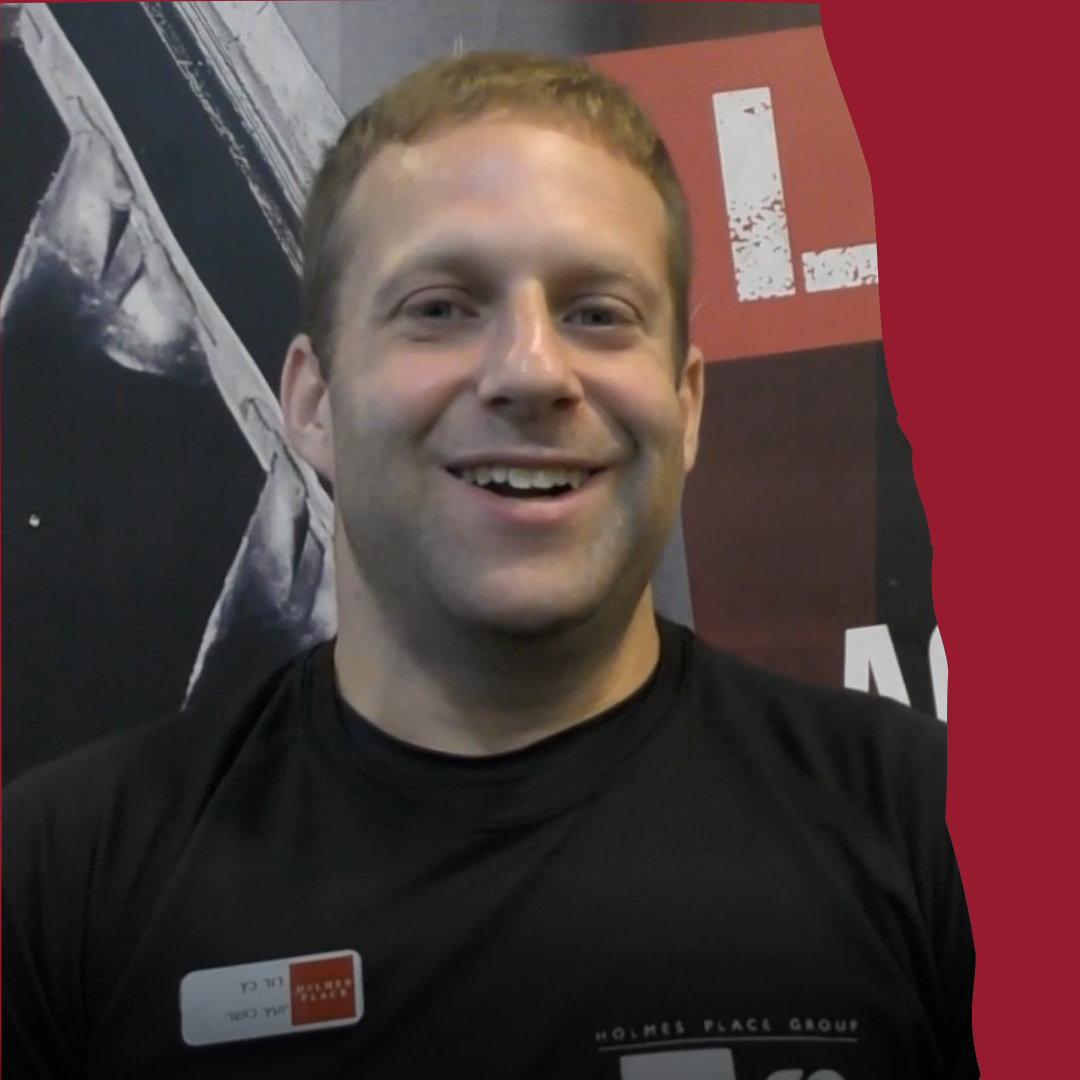
İsrail’de kişisel antrenör olan David Katz, 6 ayda 60 kilo vermeyi başardı! Nasıl olduğunu bilmek ister misiniz…

İsrail’de kişisel antrenör olan David Katz, 6 ayda 60 kilo vermeyi başardı! Nasıl olduğunu bilmek ister misiniz…

COVID-19 hastalarının, kayda değer kilo kaybına, malnutrisyona ve birçok farklı etkenden kaynaklanan vücut kompozisyonun kötüleşmesine yatkın olduğu görülmüştür. Bir çalışmaya göre COVID-19 sonrası rehabilitasyon sürecindeki hastaların %81’i nutrisyonel girişime ihtiyaç duymuştur.
Ana nedenleri aşağıda sıralanmıştır:
Öyleyse COVID -19 enfeksiyonu sonrası ve iyileşme sürecinde vücut kompozisyonu nasıl değişiyor?
Hasta başlangıçta, her zamanki gibi egzersiz yapmaya başladı. Koşmayı, yüzmeyi ve diğer egzersizleri denedi. Ancak, bu egzersizleri dener denemez kalp hızı ekstrem bir şekilde yükseldi. Evindeki merdivenleri çıkmayı denediğinde bile, SvO2 oranı %88’e düşerek, kalp atış hızı 130bpm’e kadar yükseldi. Sonrasında normal nefes almaya dönmesi 5 dakikadan fazla sürdü. Çünkü solunum hastalığı olan biri için ağır egzersizler yapılması, durumu daha kötü hale getiriyordu. Ağır egzersizlerin akciğer fonksiyonunu negatif etkilemesi, farklı bilimsel araştırmalar tarafından da kanıtlanmıştır.
Öyleyse hasta bununla nasıl başa çıktı?
Kontrollü bir şekilde egzersiz yapmaya başladı. Mutfak ve salon arasında yavaşça yürümeye başladı. Daha sonra vücut durumunu etkilemeyecek en iyi egzersizi bulmak için SvO2 ve HR oranını izleyerek, çeşitli egzersizler denedi. Sıfır efor spinning egzersizi ile SvO2 değerini %88-92 bandında ve kalp atım hızını 78-90 bandında tutabildiğini fark etti. Akciğerlerini de antrene ederek sistematik olarak daha derin nefes alacak şekilde egzersiz yaptı. Ayrıca COVID-19 pankreası etkilediğinden, kan şekeri seviyesini de takip etti.
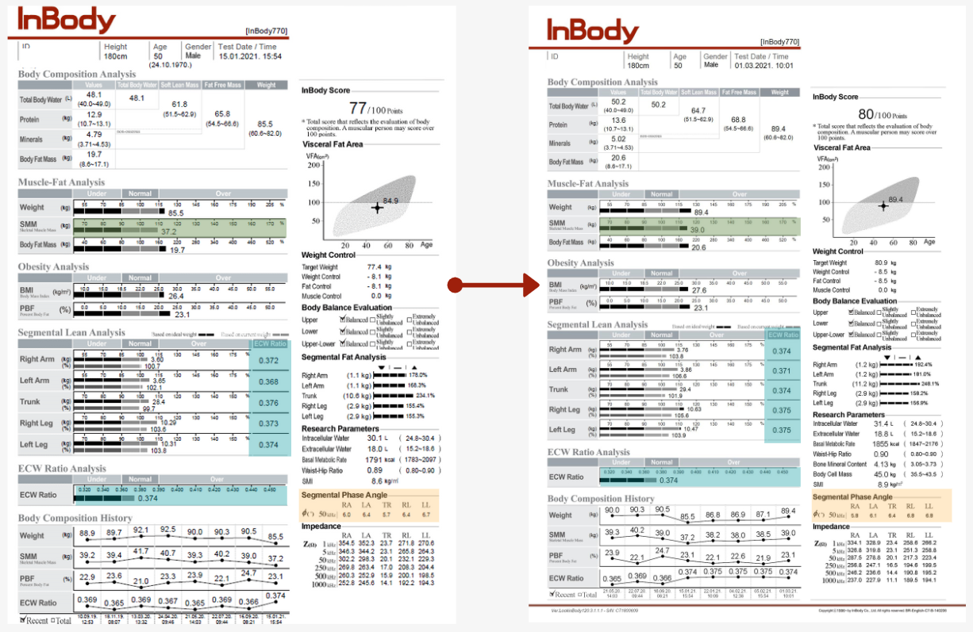

Aşağıda gösterildiği gibi, egzersiz sonrası,
COVID hastalarının çoğu kilo kaybı/ kas kaybından mustariptir (hastaların yaklaşık %61’i toplam vücut ağırlığının %5’ten fazlasını kaybetmektedir), ve daha sonrasına kas ve kilo arttırılması hastalar için zor, ancak oldukça önemlidir.



COVID-19’dan önceki sağlık durumuna dönmek için, vücut kompozisyonunun yakından takip edilmesi gereklidir. İyileşme sürecinde, sadece kilo almaya odaklanılırsa, önemli beslenme göstergelerine (ECW oranı, Faz Açısı) ve yağ/kas yönetimine ulaşılamaz. Önemli faktörler yönetilmeden, beslenme durumu normale dönemeyebilir.
50 yaşındaki bu kişinin sonuçlarına bakarsak, bazı parametrelerin düzeldiğini görüyoruz, ama ECW oranı ve Faz Açısının önceki haline dönmediği görülmekte ve aynı zamanda hasta vücut durumunun da eskisi gibi olmadığını düşünmektedir.
Birçok COVID-19 hastasında, iyileşme sürecini gözlemlerken sadece kiloya odaklanılıyor, aslında iyi bir iyileşme, vücut kompozisyonunu gözlemleme ve yönetme ile mümkün olabilir.
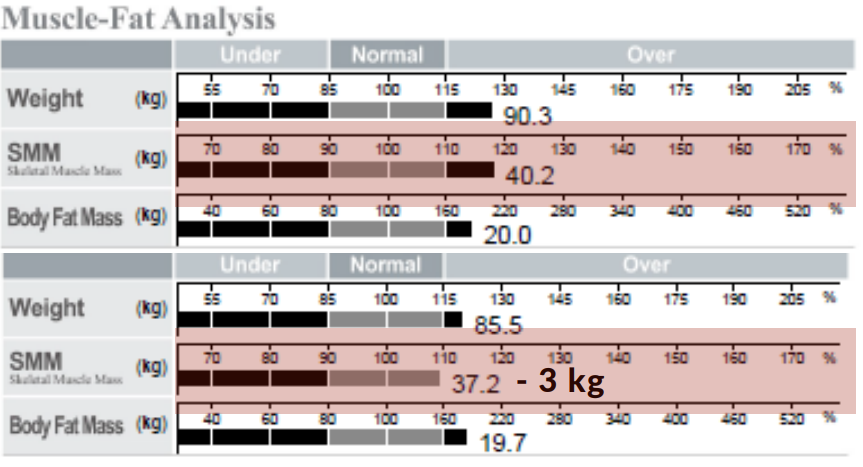

1) Hastalar enfekte olduğu süreçte, fiziksel aktivite azalmaktadır.
2) En önemli COVID sonrası semptomlardan biri yorgunluk, ki bu da COVID sonrası dönemde hastaların egzersizden kaçınmalarına neden olmaktadır.
Yukarıda bahsedilen iki madde kas kaybına neden olabilmektedir. Sarkopeniyi engellemek için, kas kütlesini izlemek ve kas kaybetmemek için uygun bir tedavi almak önemlidir.
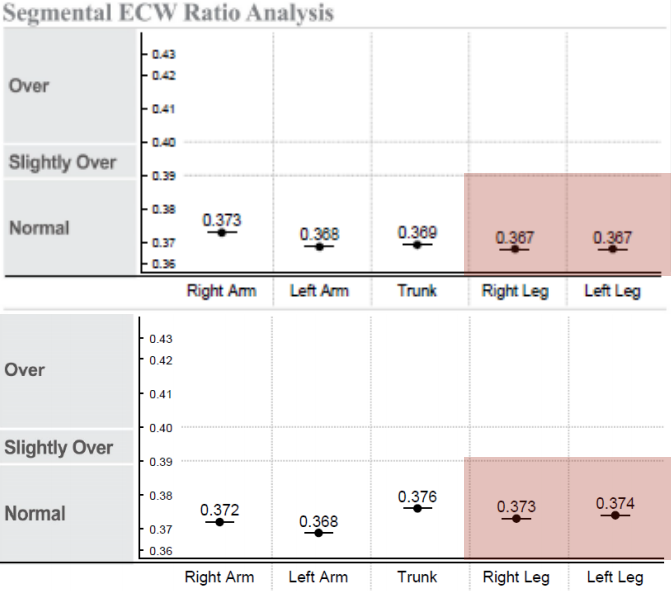

ECW oranı, Hücre Dışı (Ekstraselüler) Suyun Toplam Vücut Suyu oranı, vücut su dengesinin kontrol etmede önemli bir göstergedir. Hastalık süresince ortaya çıkan akut sistemik enflamasyon, ECW oranını yükseltebilir.
Ayrıca, ECW oranı vücut durumunu hassas bir şekilde gösterdiğinden, hastanın iyileşmesini takip etmek için kullanılabilir.
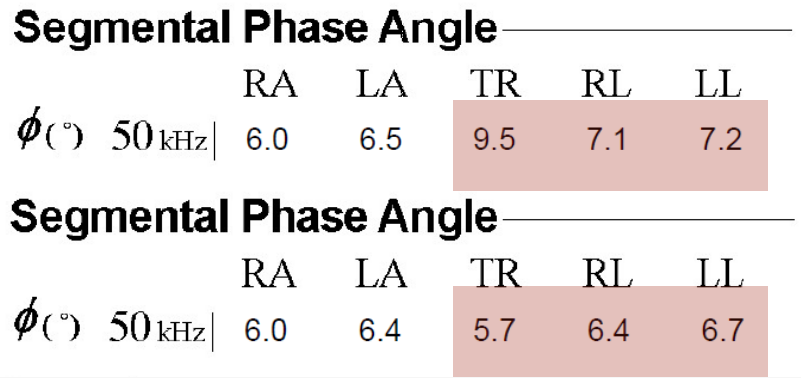

Faz açısı, beslenmenin ve çeşitli hastalıkların şiddetinin değerlendirilmesi için kullanılan klinik öneme sahip bir biyoempedans parametresidir. Düşük Faz Açısı yetersiz beslenme, enfeksiyon ve kanser olan hastalarda ve yaşlılarda sürekli olma eğilimindedir.
Faz Açısı ayrıca COVID-19 sonrası hastaların iyileşmesini izlemek için de kullanılabilir.
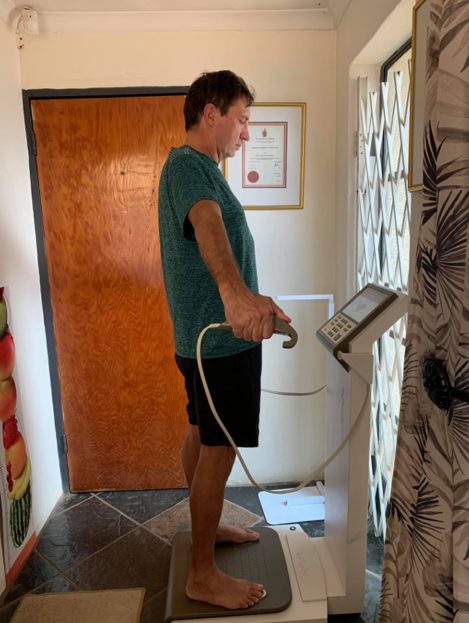

ECW oranını ve Faz Açısını gösteren vücut kompozisyon analiz cihazı hakkında daha fazla bilgi almak isterseniz, lütfen bizimle iletişime geçin.

Starport is designed to promote the welfare and morale of the Johnson Space Center (JSC) workforce. Starport Services is a quality-of-life program that directly supports the mission of the Johnson Space Center by providing a variety of support activities and employee services. These activities and services seek to enhance work-life balance, promote mental and physical fitness, and provide a working environment at JSC that helps to attract and retain quality employees.
When tasked to find new “dynamic wellness” technology to enhance their fitness and wellness program, Starport brought in an InBody 770 to replace their existing body composition tools: calipers and handheld BIA devices. In 2015, Starport’s membership grew by 48.6% and increased its workplace wellness program adoption rate to 38% of eligible employees and contractors.
While NASA’s astronauts, scientists, and researchers are committed to an unending mission to explore the universe and expand mankind’s understanding of the unknown, Starport – the workforce wellness program at the NASA Johnson Space Center – has a more immediate, earth-bound mission: to attract, retain, and support the health and wellness of the JSC’s 11,000-strong workforce of government employees and contractors.
How does Starport do that? The same way any NASA-affiliated group does: by providing its employees with the best tools for the job. Which is why, in late 2014, Employee Wellness and Fitness Services Manager Evan Thoman brought in the InBody 770.
“We want to offer our community the very top, the top echelon if you will, in terms of equipment and/or access to tools or resources to allow them to improve their health and wellbeing, and that doesn’t mean just another treadmill. It means something much more than that,” said Thoman.
Previously, Thoman had been using calipers and handheld bioelectrical impedance devices to determine body composition with limited and mixed results. When the call came from above to deliver a wellness program that would achieve Starport’s mission, Thoman remembered InBody from his previous role in the private healthcare sector. He knew that anything less than the InBody would be unacceptable for the NASA workforce: “We’re NASA, so we want to do everything we can to offer our workforce the best of the best, and at the time the InBody was – and still is – the best of the best.”
Thoman knew that the JSC workforce – an incredibly tech-savvy and data-driven population – would not just accept a new piece of technology as the “best of the best” at face-value. NASA’s workforce is used to working with the most sophisticated technology available, so when outside technology comes in, it’s often greeted with a high degree of skepticism. However, Thoman was cautiously optimistic. “I knew people would use it,” he said. “I just hoped our employees would put their trust in this.”
The key to building that trust would be education. “This population, they want to be the best at everything and know everything there is to know about a certain topic, and body composition assessments and InBody assessments are not different.”
Thoman launched a mass-awareness campaign designed to teach the workforce what the InBody 770 could do for their health and wellness. It started with teaching the importance of knowing important body composition values. Thoman had previously held “Know Your Numbers” campaigns for employees to promote awareness of metrics like blood pressure and cholesterol levels. He used this same model again, except this time on the topic of body composition, promoting awareness of values such as lean muscle mass and body fat percentage.
Once the InBody arrived in December 2014, Thoman devised a plan to implement the InBody 770 into the workplace wellness program. Taking advantage of the annual New Year resolution membership signup wave, Thoman put the InBody 770 front-and-center. “The InBody 770 was the focal point,” he said, “and it continues to be the focal point.”




Not content to let the InBody sit in the Starport gym and wait for people to discover it, Thoman took the device outside at every available opportunity. When there was a health fair at NASA JSC, the InBody 770 was there. When there was an event at a local NASA-affiliated contractor’s office, Thoman took the InBody on the road and tested people there. He even brought the InBody into the cafeteria and tested people during their lunch break.
Thoman’s efforts paid off. Starport gym members began to share their results with others who were not yet members, creating more interest and excitement among the JSC workforce. “People who had never, ever planned on having an assessment done…all of the sudden saw this results page that their co-workers were passing around and saw all of the data that it presented and then suddenly became very interested and wanted to start tracking and trending their own metrics,” he said.
“Once the information got out, once they put their trust in the machine, once it was verified…it’s just taken off, and it shows absolutely no signs of losing momentum.”




Thoman credits the InBody as a key factor driving this high engagement. Once the workforce learned about how their body composition factored into their health and wellness and understood how the InBody could help them reach their health goals, employees came again and again to track their numbers.
“It has brought so much awareness in terms of the physical health of our workforce, much more than I ever thought,” said Thoman. “People are pretty set in their ways, and this was asking them to change their routine of just stepping on the scale to measure progress.”
With 2016 well underway, Starport’s membership signups are set to again break records. Thoman has set a year-end goal of 50% of the NASA JSC workforce to be signed up for the wellness program by December. Although it’s a lofty goal, he’s confident he’ll get there with help from his InBody 770 and the trust his workforce has placed in it.
“The machine has proven itself,” said Thoman. “It’s passed the ‘NASA test’ from a trust standpoint.”
Looking for healthcare data to improve decision making to promote better patient outcomes? We can help. Contact Us

The Anaheim Ducks are an NHL team based in Anaheim, California. The Anaheim Ducks have won the Pacific division every year since the 2012-2013 season and have made the Western Conference championship two of the last three years.
Mark Fitzgerald is the strength and conditioning coach for the Anaheim Ducks and the owner of Elite Training Systems, a high-performance training center catered to athletes. His philosophy is improving player performance through training, nutrition, and rest. The NHL season is physically demanding and hectic. Thus, Fitzgerald was looking for technology that could measure his player’s body composition in-house quickly and provide accurate, informative outputs. After referrals from trusted sources and self-experimentation, Fitzgerald found his solution in the InBody.
Time constraints are an issue every NHL franchise must manage. The Ducks had the extra challenge of having the longest travel schedule in the league for the 2016-2017 season. During the course of 82 games and the 40,000+ travel miles, their players’ bodies began to break down.
“The travel and the schedule are very real issues. If you don’t take them into account in your nutrition profile, your rest, your work to rest on the ice, then you’re going to be putting your athletes in a pretty dangerous position.”
Fitzgerald created a comprehensive program to keep players healthy and ready to play. Players receive a daily report on their bodies’ readiness to perform. This allows Fitzgerald to track player condition and create open dialogue between player and coach.
Body composition is a vital metric of the assessment. The challenge was how to test the players consistently and accurately.
Fitzgerald had experience working with calipers and although they were quick and easy to use, he found the results were inconsistent.
The organization had access to a DEXA through a partnership with a local university. But to send players outside the facility, even just a few miles up the road, was difficult. When the team wasn’t traveling, the team was trying to accomplish a lot in the limited time available in the facility. The players had practice, film sessions, conditioning, etc. Although body composition testing was important, the time it was taking to test was taking away valuable time that could be put into other more productive activities. To get all 20 players tested with a 10-minute DEXA scan outside the facility was almost impossible to perform on a regular basis.
The idea of bringing a DEXA scanner in house was a logistical nightmare of its own.
What Fitzgerald needed was an in-house tool that was fast and convenient like calipers that also provided the accuracy and consistency of a DEXA.
“We use a lot of technology in Anaheim, and I’m careful with what technology we do bring in because I want it to be valuable. I want it to be something I can use for a long time because the value of all this testing data is to do it consecutively and to do it over a term and that’s where the value of what we’re trying to do here is seen.”
After reviewing and comparing other body composition devices on the market, Fitzgerald found what he needed in the InBody.
Fitzgerald was familiar with the other BIA devices on the market, but what separated InBody was who was also using the device.
“From day one, InBody did not have to sell me on it. It’s always been, “Here’s what we do. Here’s who’s using us. Talk to any of the teams that are using it. Talk to them and see what they say. To me that’s huge.”
Over 30 teams from the NHL, NBA, NFL, and MLB were already using InBody as well as the top names in strength and conditioning.
Todd Durkin, two-time Fitness Trainer of the Year and a personal colleague, was receiving exceptional results from using it at his facility. His satisfaction with InBody convinced Fitzgerald to give it a try.
Fitzgerald tested the InBody on himself once a week, same time everyday, in the same fasted state to check consistency.
After only two tests, he began seeing consistency in the testing results. A few more tests later, Fitzgerald began realizing the multitude of applications he could use with the outputs from the InBody. The more Fitzgerald tested, the more satisfied he became with the InBody. Next, he took the results to the Ducks’ university partner.
What the university told him blew him away.
“The university that we work with was able to validate, in some studies that they did, that it’s a valuable tool. When the university compared it to some of the other more expensive methods, the Bod Pod and the DEXA, they said it was right along with them.”
After trusted recommendations, self experimentation, and validation from a top university, InBody became an easy choice.
The ease of testing and the quality of information of the InBody 770 became a game changer. In 60 seconds, the InBody 770 gave Fitzgerald and his team accurate measurements of fat mass, skeletal muscle mass, and body water in each segment of the body.
Fitzgerald is now able to test his players on a regular basis in-house and collect vital data to tailor his training for his players needs.
All of the outputs from the InBody Test are provided on the InBody result sheet, which Fitzgerald uses to open dialogue with athletes on areas to focus on. At the highest level of professionals sports, open dialogue between coach and athlete is paramount. Professional athletes want to understand what they are doing. For Fitzgerald, the result sheet is essential in the education process. The InBody provides outputs that Fitzgerald can tie to his diet plans and workout plans.
Two areas of focuses are on nutrition and conditioning. His goal for all his players is to maintain a balanced, strong body so that they can stay on the ice.
Fitzgerald uses lean body mass to set targets for each of his players to maintain during the season. As the number increases or decreases, he can relate it back to what they are doing for nutrition.
“If you eat more higher sources of protein, it’s going to keep lean muscle mass on, you’re not as susceptible to soft tissue injuries and you keep that lean muscle. When one leads to the next and they’re intermingled, it brings more relevance to what I’m saying. It’s full circle.”
This helps reinforces the importance of diet and supplementation.
Fitzgerald uses the Segmental Lean Analysis section on the InBody result sheet as a guide to help the athlete better understand their body. Most hockey players are asymmetrical because they usually shoot a hockey puck off their dominant leg, working one side of the body significantly more than the other. A hockey player might not feel like they are physically unbalanced, especially if they are performing well. But an asymmetrical body can be vulnerable to injuries.
“Looking at the segmental analysis you’re able to tell them that’s why that happens. That single leg and single arm work I have you do – that’s why I have you do that work. We want to be able to balance those two things out. It’s never going to be perfectly balanced but we try to keep them a little more balanced than they are. Again, it opens the door for conversations.”






The InBody result sheet makes that easy to understand.
Fitzgerald feels his value is in taking all the data, make sense of it for the players, and creating personalized plans. At the Duck’s training facility, they can take an athlete’s force plate number and see an athlete’s force production during a workout. He can then take the outputs of the InBody 770 provides to make correlations.
If an athlete has increased their force production by 5% over the last four weeks, Fitzgerald can compare those results to the InBody output. The InBody can show that after the addition of quality protein in the diet lean body mass increased. Or the addition of a single leg workout routine has lead to better balance between the right and left leg.
Fitzgerald can show his players with data that their efforts in nutrition and conditioning has directly lead to an increase in performance. That creates understanding for the players and validation for him and his programs.
“If you can find a way to help the athlete make sense of why they’re doing what they’re doing and how it benefits them, you’re ahead of the game. InBody allows me another tool to do that. It helps that [the Result Sheet is] tangible and it’s something they can hold onto.”
Using the InBody result sheet to create that connection between nutrition, training and improvements has led to buy-in from the players. Since implementing the InBody as a component of the program, the Anaheim Ducks have seen a reduction in injuries compared to years prior.
When Fitzgerald entered the franchise, his goal was to improve player health by creating a program that would encompass player strength and conditioning, nutrition, and rest. With the InBody, not only was Fitzgerald able to test his players quickly and accurately, but he also was able to use the InBody result sheet to create buy-in from his players.
“With the InBody print out, it open dialogue with the athlete, “Hey, what does this mean? Am I trending in the right way? How can I improve?” When you open those conversations with your athletes, that’s why I’m here. That’s why you coach.”
After adding InBody to his program, Fitzgerald has been able to take everything he is doing and bring it full circle. Players understand better why Fitzgerald has them train and eat a certain way because the InBody result sheet provides them objective proof. They buy in and are more committed to the program. After committing fully to the program, the players feel stronger, perform better, and stay on the ice.
“How many guys on our team played every game? I think we had quite a few compared to the last few years. How many guys that had injury issues in the past don’t have them anymore? We’ve made an intervention and changed what they’re doing and guys are happy to be in here every morning and happy to be part of what we’re doing.”
Looking for healthcare data to improve decision making to promote better patient outcomes? We can help. Contact Us

Western Digital is a Fortune 500-listed company and is one of the largest computer data storage and hard disk drive manufacturing companies in the world. Western Digital encourages its employees to develop and maintain active and healthy lifestyles through its DRIVE Wellness Program, which provides educational seminars, workout equipment, health counseling, and coaching to its workforce.
After encountering and using an InBody at an area fitness center, Senior Wellness Specialist Heather Whitaker saw the potential to bring DRIVE Wellness’ offerings to the next level. After seeing the effect it had on a pilot program of 200 employees, Whitaker brought in an InBody 570 as an educational tool available for employees to get a better understanding of their health and to inspire them to become healthier and allow them to be more productive.
Like many wellness specialists at large corporations, Heather Whitaker, Senior Wellness Specialist at Western Digital’s DRIVE Wellness Center has a mission: to provide services that benefit the health of the workforce at Western Digital. While that’s easier said than done, Whitaker has a clear methodology.
“Ultimately I’m trying to educate employees,” she remarked. “I’m not trying to tell our employees what to do and how to do things; [it’s] the rationale – the reason behind why. We’re trying to make employees see that they need to be good healthcare consumers for themselves and for their family.”
But how to communicate that, and more importantly, how to get employees invested? Fortunately for Whitaker, a chance encounter provided a solution.
“I first heard about InBody at a local gym I was working out at. They were doing a 12-week fitness challenge, and part of that challenge was to use the scale to help dictate where your body needed to go.” Going through that challenge herself got Whitaker thinking: what if the Western Digital employees could use the InBody too? So, she tried it out.
200 Western Digital employees chose to enroll in the 12-week fitness challenge at the local gym with InBody. The results were astounding. “Collectively, they lost close to 4,000 pounds of fat. Not weight, but pure fat. We would have never known that had we not used the [InBody],” said Whitaker.
Impressed by the results of the trial, Whitaker made the decision to bring an InBody 570 to Western Digital for the opening of DRIVE Wellness.





Bringing awareness to the Western Digital workforce, with body composition as a significant portion of that awareness, became central to Whitaker’s work towards her goals. Her InBody scale brought that awareness in a comfortable, non-intimidating way.
“When you’re overweight, you don’t need anyone telling you you’re overweight; you already know,” said Whitaker, “but by getting on the InBody scale it’s breaking it down for you. It’s making it more relatable and understandable.”
That breakdown has proven to be a key for getting employees at Western Digital invested in their own health. The data the InBody provides the healthcare professionals at Western Digital has also proven to be a convenient and clear way to talk to employees about their health risks associated with excess body fat.
“One of the ways our physician uses the InBody scale in physicals is to look at the visceral fat level. Once it gets to a certain point, he can help them understand that if they don’t lose some body fat – especially in the abdomen area – it’s going to increase their risk for heart disease, high cholesterol, [and] high blood pressure,” said Whitaker.




By having the InBody results available to employees, Whitaker is able to provide another educational moment. These moments can be eye-opening for employees and are crucial to inspiring them to take ownership of their health and wellness.
“I would say that the biggest success stories that we’re having are people feeling [that] there’s a light at the end of the tunnel,” said Whitaker, “in that working with their health coach here they can come whether it be weekly, every other week, monthly, or whatever works for them and they can actually see progress.”




Currently, DRIVE Wellness only exists at Western Digital’s headquarters in Irvine, CA. However, based on the success Whitaker has been able to achieve, she plans to open up two more centers at Western Digital’s locations in the San Jose Bay Area. She’ll be bringing what worked at Irvine to the employees up north, and that’ll include an InBody device.
As Whitaker sees it, it’s a must-have.
“I have people come through all the time who come and look to see our wellness center…and I always show them the InBody scale,” she says. “I let them know that it’s such a key tool in a wellness center that…maybe cut back on certain areas, but make sure you have the scale, make sure you have a health coach that can use and have doctors that can understand it.”
“I just think it’s a great tool that people can use, and it just makes understanding your overall body composition so much easier.”
Looking for healthcare data to improve decision-making to promote better patient outcomes? We can help. Contact Us
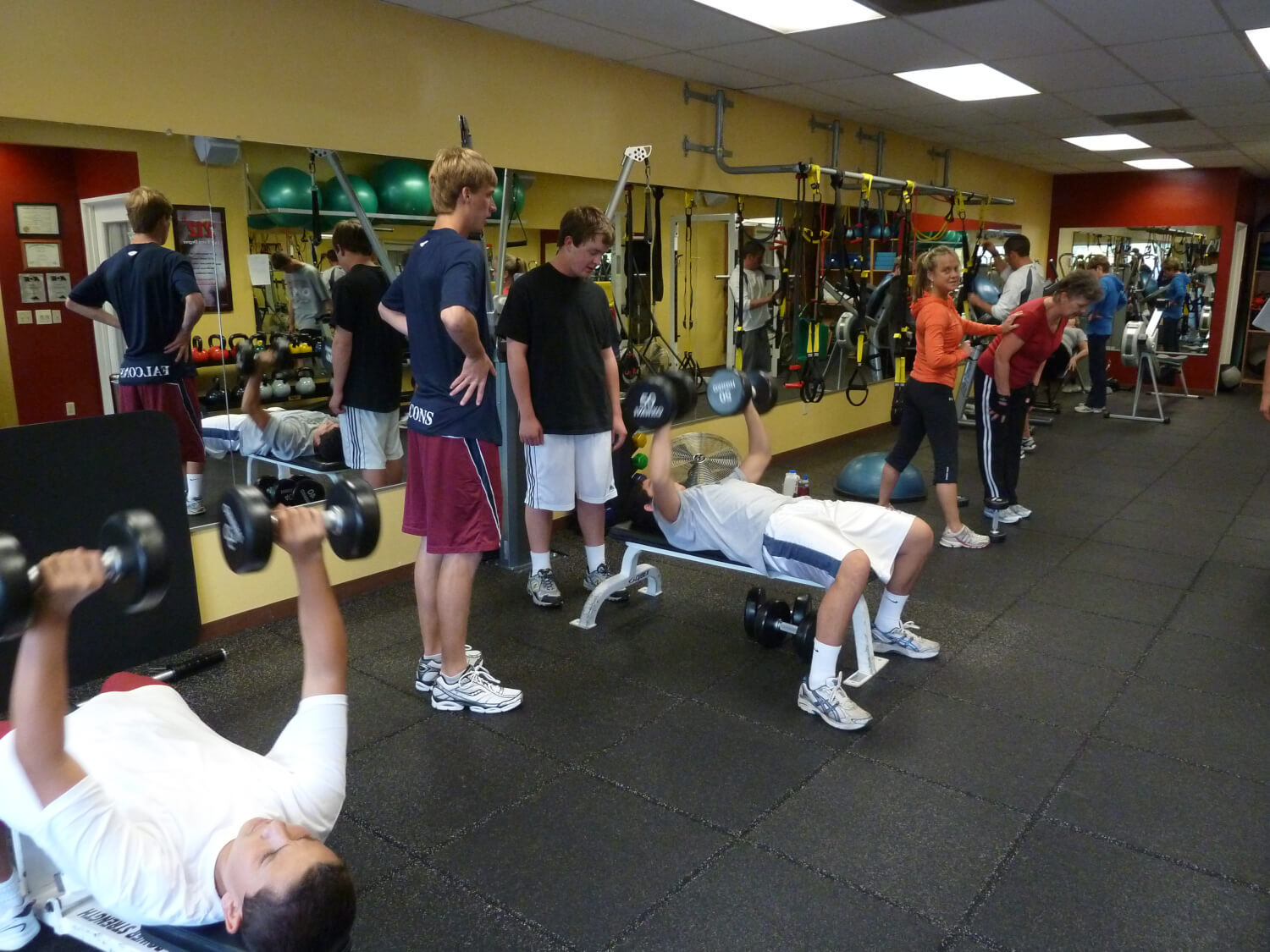
Todd Durkin is an internationally recognized strength, speed and conditioning coach, personal trainer, motivational speaker and author who inspires and educates people worldwide. Durkin has won Personal Trainer of the Year (IDEA and ACE) twice and has been listed as “Top 100 Most Influential People in Health & Fitness” (Greatist) four times.
He owns Fitness Quest 10 in San Diego, which has ranked as one of “America’s Top 10 Gyms” by Men’s Health five times. Fitness Quest 10 provides personal training, therapeutic massages, Pilates, nutrition and, more to people of all ages, shapes, and sizes. His clientele includes everyone from elite professional athletes to people who want to improve their health.








Fitness Quest 10 is the culmination of Todd Durkin’s professional and personal experiences. After a serious back injury, Durkin spent the next five years focused on healing his back without surgery. He learned to combine the latest innovations in sports science with holistic techniques. Today, that knowledge and focus is applied at Fitness Quest 10, recognized as one of the leading facilities in fitness.
“Regardless if it’s a guy I’ve been working with for years, a NFL quarterback or the lightweight champion of the world, we want to make sure we offer them the best service in training and technology around to monitor their progress.”
A major reason behind Durkin’s success was his never-ending commitment toward serving his clients. As part of that commitment, Durkin never hesitated to travel to learn the latest training techniques or invest in new fitness equipment because his passion was always to help his clients reach their goals.
However, all of that energy and commitment was almost wasted because, for years, he didn’t have a method to measure his clients progress accurately.
For the past sixteen years, Fitness Quest 10 relied on calipers to measure their client’s body fat composition. Each client worked with two or three different trainers, and results would differ based on who was testing. One tester might measure 17 percent body fat while another might test 23 percent body fat. The inconsistency was frustrating for trainers and clients because no one could tell objectively if progress was made.
To control consistency, the number of testers were limited to the most experienced trainers. This meant limited testing opportunities for clients. Some clients were going six months or longer without getting tested. Without the data, Durkin and his team had no objective way of knowing how effective their training methods were.
Durkin tried many different solutions. Hydrostatic weighing provided accurate results but created its own problems. First, many clients were unwilling to strip down into a swimsuit and get into a tank of water in order to get tested. Second, because of the size of the tank, it would be difficult to provide hydrostatic weighing as a service at the facility.
After 16 years, many other trainers would have given up and accepted this problem as unsolvable. But for Durkin, he had to solve this issue if he wanted to achieve his dream of providing the best possible fitness experience.
“In the training world, it’s not about us. It’s about the member and how can you create an experience for them that’s going to be world class, that’s going to be superior, that’s going to be the Ritz Carlton or Nordstrom’s and deliver that experience where they say ‘Wow, this is incredible!’.”
Whenever Durkin faces a question or a challenge that he doesn’t have an answer for, he turns to his mastermind network for help. A mastermind is a network of top professionals that collaborate together to improve their craft. And he found that many members of his network were already using InBody to measure their clients’ body compositions. Durkin was initially skeptical of Bioelectrical Impedance Analysis (BIA), the technology InBody is based on. Durkin had experience with BIA handheld devices and he found those results inaccurate. But at the urging of his mastermind network, he investigated further and he became a believer.
Durkin felt that he may have finally found a viable solution when he saw the caliber of organizations that trusted InBody.
“If there are professional sport teams and universities using [InBody], why shouldn’t leading training facilities be using it as well? As trainers and fit pros look for solutions, you want to look for solutions that are going to give you an ROI and keep your client and members happy. I believe InBody is an incredible solution.”
After Durkin brought in the InBody, he quickly saw the potential. Anyone could use the device with ease, whether it be a front desk person or trainer, and be able to test thousands of clients consistently and accurately. And the InBody result sheet printout provided his clients with a wealth of information that they could take home and study on their own time.
Countless people have raved about the helpfulness of the InBody Result Sheet. After finishing a program, people could get their result sheets laminated, bring it home, and show it off to their families. Durkin found that an astounding 90% of people want to get retested. Now instead of having to remind people to come back for a follow-up test, people are scheduling themselves to get tested. Now he and his trainers have the data to better serve their clients. As Durkin likes to say “What gets measured, gets done”.
Initially, the focus was to figure out how to measure body fat composition accurately and consistently. Durkin found the InBody 570 provided those outputs as well as so much more.
Fitness Quest 10’s trainers use the InBody Result Sheet as an educational tool to teach their clients about how the programs were affecting their bodies. Most clients would only focus on weight loss. With the Segmental Lean Analysis section on the result sheets, clients were now able to see and understand the importance of muscle.
Pounds of lean muscle in each segment is shown along with the ability of the segment to support the body’s weight. The segments can then be compared to each other to determine proportionately and to a recommended range as a guide for training.
Clients were also able to learn about something they’ve never thought about before: visceral fat. Everyone knows about subcutaneous fat, the fat that appears right under the skin. But most people don’t know about visceral fat, the fat around the organs. Dangerous health complications are associated with excess visceral fat– and it can’t be measured with calipers. Through his InBody 570, Durkin is able to show how his fitness programs are helping clients lose both visceral and subcutaneous fat to positively impacting their well-being.
The InBody Result sheet measures visceral fat on a scale of 1-20. High visceral fat increases risk for anxiety, cancer, stroke, heart attacks, and other life-risking diseases.
Another important output that clients of Fitness Quest 10 found useful was Basal Metabolic Rate. With BMR, trainers are able to effectively address nutrition for each individual client. Trainers could also use BMR in combination with Fitness Quest 10’s heart tracking technology to a set specific caloric intake target tailored for each individual. So if a client was looking to decrease fat mass, a caloric intake would be set below the BMR plus the addition of calories burned through a workout.
Durkin found that InBody took the guesswork out of creating nutritional plans and exercise recommendations for each of his clients. He could show exactly how his clients were progressing with tangible data.
As a responsible business owner, Durkin always asks himself “Is it an expense or is it an investment?” when he brings new technology to his gym.
He found that 90% of his revenue came from existing members and 10% came from client acquisition. And InBody helped generate more revenue from both channels.
The informative outputs from the InBody 570 results sheets encourage his current clients and keep them coming back by showing their progress through numbers they can track. New clients are attracted to Fitness Quest 10 because the InBody allows the facility to offer a unique service.
InBody has proved to be a valuable recruitment and retention tool. Durkin offers InBody testing as part of the “feeder programs” he runs outside the facility. “Feeder programs” are boot camp style workouts with nutritional support that run for a four-week cycle. By testing before and after the program, new clients can see the immediate impact of their training on their InBody Result Sheets. The Result Sheet has become a great introduction to Fitness Quest 10 and its services.
Durkin has folded the InBody into part of his membership program. Durkin sells membership packages that offer up to four test a year. Anyone that wants personal training services will get the ability to test every 90 days to check their progress in a consistent manner. When people want to test more frequently, they can pay an additional fee to get a test. Because so many people want to test as often as possible, InBody has become a new revenue stream for his facility.
Today, Fitness Quest 10 can now offer a complete and accurate assessment that tests body composition, functional movement, and fitness for each member– which in turn, proves objectively that his services are improving his client’s well-being.
For Durkin, InBody has not only been able to solve a 16-year-old challenge, but he has been able to completely revamp his business with this new device. Clients are now educated on visceral fat and nutrition with objective numbers. And by providing InBody tests as a service, Fitness Quest 10 now has a new and continuous revenue stream.
Durkins says that not only is InBody a gold standard for measuring body composition, but InBody is an investment that will help your facility stand out.
“I believe the best and the strongest will survive. When you’re in the fitness industry, you’ve got to offer your clients the best unless you’re looking for a cheap solution. Then you’re going to compete on price. That’s the wrong game to be playing. You want to make sure you can distinguish yourself and do things that are different in your community. What’s going to make you different is assessment. For [Fitness Q10], InBody is one of the best ways that we’re using now to leverage technology and innovation .”
As Durkin says, “I want to surround myself with people that are world class and companies that are world class and that’s why I’m excited to have InBody represented here at Fitness Quest 10.”
Looking for healthcare data to improve decision making to promote better patient outcomes? We can help. Contact Us
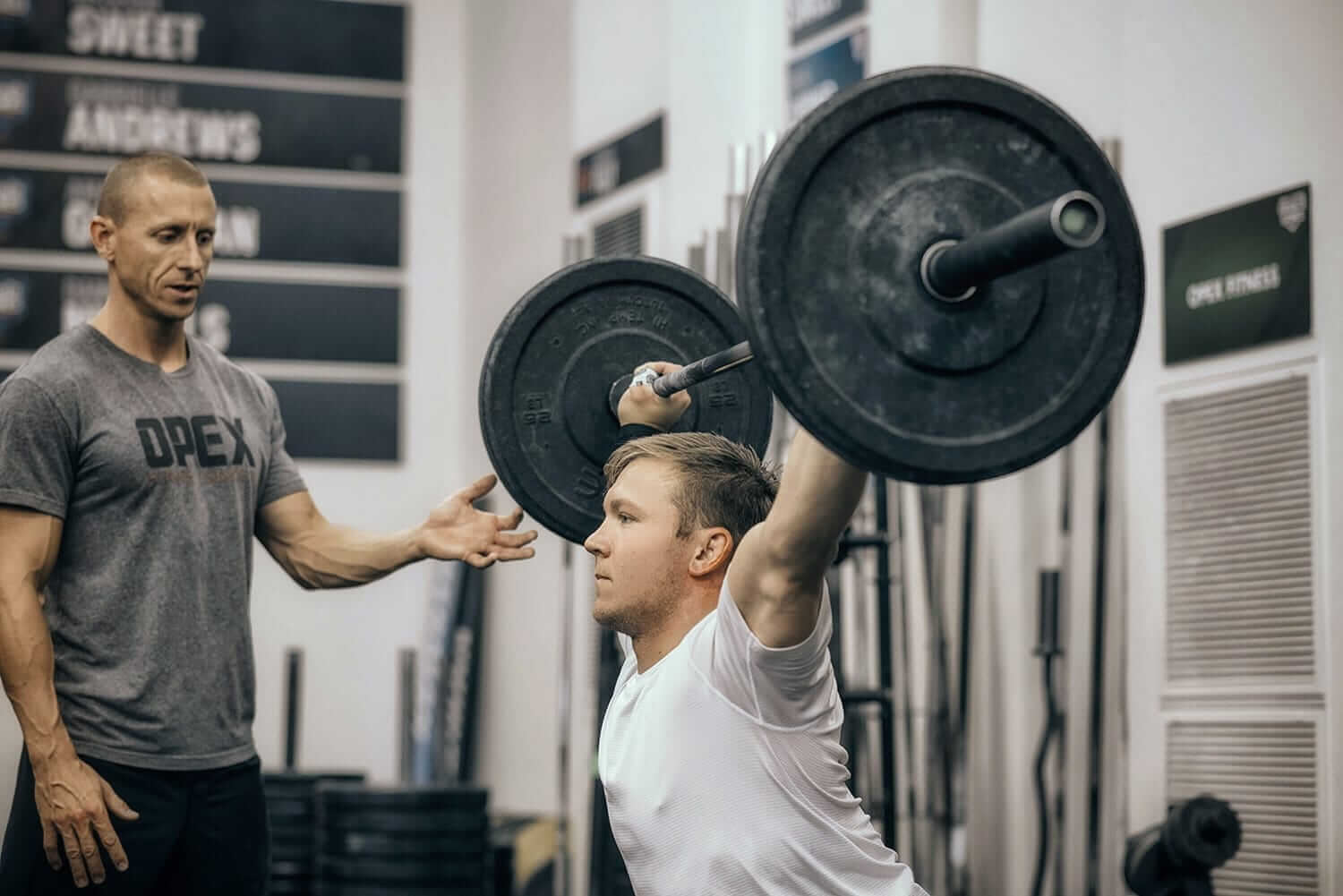
OPEX’s culture of challenging the status quo in fitness began with founder James Fitzgerald. He began his career in clinical research and has written studies on muscle fatigue published in Physiology Canada, The Canadian Journal of Applied Physiology, and the Journal of Strength and Conditioning Research. In 1999, he started applying his research to the real world when he began coaching fitness. Fitzgerald gained the attention of the fitness world when he won the inaugural 2007 CrossFit Games by applying his research knowledge to training. Seven years later, he opened the OPEX Fitness facility, now one of the leaders in coaching education and functional athlete training in the world. Today, OPEX Fitness has certified 1900 coaches worldwide and produced 75 Crossfit Games competitors and one Crossfit Games champion.
Fitzgerald applies the same standards of integrity and accountability that are expected in academic research to his coaching. When he looked for a valid method for measuring body composition at OPEX Fitness, he studied what devices were used in the fields of medicine and research. After exploring all possible options, Fitzgerald decided on InBody, a DSM-BIA device used by doctors and researchers in leading facilities around the world.
Today we find that many fitness professionals are too focused on creating marketable fitness programs that sell instead of focusing on the individual needs of their clients. That means designing “new”, “innovative”, “one-size-fits-all” programs that all promise more dramatic results in less time. There is a competition to be the best solution with the fastest results, but many of these programs provide little to no data to back their claims.
“Marketing is now stronger than education, so the truth in science has been questioned. It’s not uncommon to see fake news — or fake science — being plastered everywhere.The consumer now has no idea what is [true] in fitness.”
Fitzgerald saw a need for a fitness program backed by research that would be able to show real progress through valid measurements. If he could show his clients the real changes that were happening beneath the surface, he would create buy-in and keep clients coming back. This inspired him to create a system that could track this progress, which he named OPEX Body: a comprehensive individual assessment process. It factors in an individual’s physiological profile and fitness ability to create a biological marker, a starting point for their fitness journey.
“This is what your marker presented today. Based upon your goals and what you want to do, here’s the plan that’s going to lay out how to get you there, and we’re going to use this marker to continue to measure that over time.”
The marker helps coaches identify client’s strengths and weaknesses and prescribe a tailored fitness program based on the client’s flexibility, strength, and endurance. Together, client and coach can see the improvements in body composition and vital signs. And together, they can make adjustments to ensure there is a continual progression toward their goals.
The OPEX assessment process was refined over 25 years of trial and error. At the beginning of his career, Fitzgerald was trained to measure body fat composition through multiple hand-caliper devices to create a fat score. One client would get six or seven different versions of a body composition score. He felt he was not actually measuring the client, but he was actually choosing a score to fit the client. However, calipers remained an industry standard because they were cheap and easy to use.
Fed up, he realized that all the positives of calipers were overshadowed by its negatives. He had the ability to create a perfectly tailored training program to get someone to their goal. However, if his measurements were wrong, his entire program would be based on a faulty assessment and not on the client’s individual needs.
Fitzgerald decided he needed to upgrade his tools and started studying what medical professionals and researchers were using for body composition: DEXA, Bod-Pods, underwater weighing and bioelectrical impedance.
“Going from calipers to any of those [devices] wasn’t as economical. But I want the truth. So I’ll do whatever it takes to get the truth”.
During his search, he came across InBody at his doctor’s office. His doctors were using InBody to assess patients to determine their baseline. They would then use this baseline as a guide to improve patients’ function, rehabilitate them, and increase their longevity. He immediately saw the value that the InBody provided. Here was a medical-grade device that could provide an accurate, in-depth analysis of an individual’s body composition. The results were an actual measurement of the individual, not an estimate or calculation based on age and gender.
Intrigued, Fitzgerald wanted to test the InBody against other body composition devices.
He took different types of body composition devices- BodPod, different kinds of caliper devices, DEXA, underwater weighing, DSM-BIA – and put them all against one another. The goal was to compare InBody’s accuracy to other gold-standard devices and understand the differences between the measurements. Fitzgerald even invited representatives from each body composition company to OPEX Fitness to demonstrate their devices themselves to ensure he was following the testing protocol perfectly. Then he changed the variables to see if InBody was really too good to be true.
“InBody became the number one answer because we tried to break the system, we tried to cheat the system, and there was no way we could cheat it: it still gave us the truth in what it was scoring no matter how hard we tried.”
Fitzgerald specifically went against testing guidelines to see how each device would respond. He tested people both pre and post workouts, wanting to see a change in the structure of water. In other devices, he was unable to see the real changes that the body undergoes after a workout. However, the InBody was able to clearly show the body water differences in the athletes, making it the clear winner against all the other devices.
“Nothing beat the InBody for repeatability and the validity of what we’re trying to get with what we want, which is the truth in numbers to give us indications as to how the fitness program is doing.”
Today, OPEX has fully integrated InBody into its methodologies, whether they are training high-level athletes or regular Janes and Joes. All OPEX clients use the InBody as part of their initial and continuing assessment process. Fat and lean body mass measurements that the InBody provides are points of emphasis because they help tie in all of the services that OPEX Fitness provides.
For example, a client’s lean body mass measurement is not only used to guide training programming but for nutritional planning as well. The InBody Result Sheet shows the level of lean mass in each segment of the body, if that segment is adequately developed, and how balanced each segment is to one another. An OPEX Fitness coach will then create training programs based on the specific needs of that client.






From there, the coach can explain how their lean body mass level will affect their metabolism, or basal metabolic rate, which is a building block for a nutritional plan. Because the InBody Result Sheet provides a baseline of how many calories the client’s body burns naturally per day, it is easy for coaches to give an exact number of the macronutrients that are required to fuel lean body mass gain while still losing fat mass.
Finally, OPEX coaches can make the connection to overall health as the lean mass increases and fat mass decreases. The InBody visceral fat measurement shows if a person’s visceral fat falls within the healthy range. By decreasing visceral fat, coaches are helping their clients lower their risk for health complications in the future like heart diseases and diabetes. This data helps make the connection between how physical health relates to overall health for the client and instantly creates more credibility and value for OPEX Fitness.
InBody body composition testing has also allowed Fitzgerald to upgrade the coaching for OPEX’s sponsored Crossfit athletes. They are able to combine the outputs of the InBody with other tools at their facility to gain new insights. One insight they have gained was found by comparing Forced Expiratory Volume to InBody’s lean body mass measurement.
Forced Expiratory Volume (FEV) is an indirect measurement of lung capacity. By comparing the lean body mass measurement with the total amount of air exhaled, OPEX coaches can examine the oxygen exchange capability. In layman terms, this is a look at an athlete’s endurance. It is no longer a mystery why two similar level athletes on comparable training programs don’t have the same level of output. By examining the oxygen exchange capability, OPEX coaches can see that these two similar athletes may have comparable levels of lean body mass but a large difference in lung capacities. The InBody gives a precise lean mass measurement to enable OPEX coaches to say: “you have a lot of muscle, but you don’t the oxygen exchange capability to support that muscle, we really need to improve that exchange”. Adjusting the training to improve exchange will increase output and that is tremendously important in a sport like Crossfit.That insight has helped OPEX coaches to improve their team’s performance.
Although Fitzgerald doesn’t like the state of fitness today, he is encouraged by the direction it’s heading toward. The general public is beginning to realize the importance of measurements when it comes to setting and achieving health goals. People will want an individualized score that is truly representative of their body, and the technology to provide these scores is becoming increasingly accessible and accurate. Fitness instructors will need to learn how to interpret those scores and make appropriate programs based on where the individual is at in terms of their health.
“With the future of biotech and the interest level in that, my belief is that companies like InBody will hold the key for the connection between the best prescriptions possible to help people to live large and long and prosper. InBody has a big part to play in the future and OPEX will be right alongside InBody doing that.”
Looking for healthcare data to improve decision making to promote better patient outcomes? We can help. Contact Us
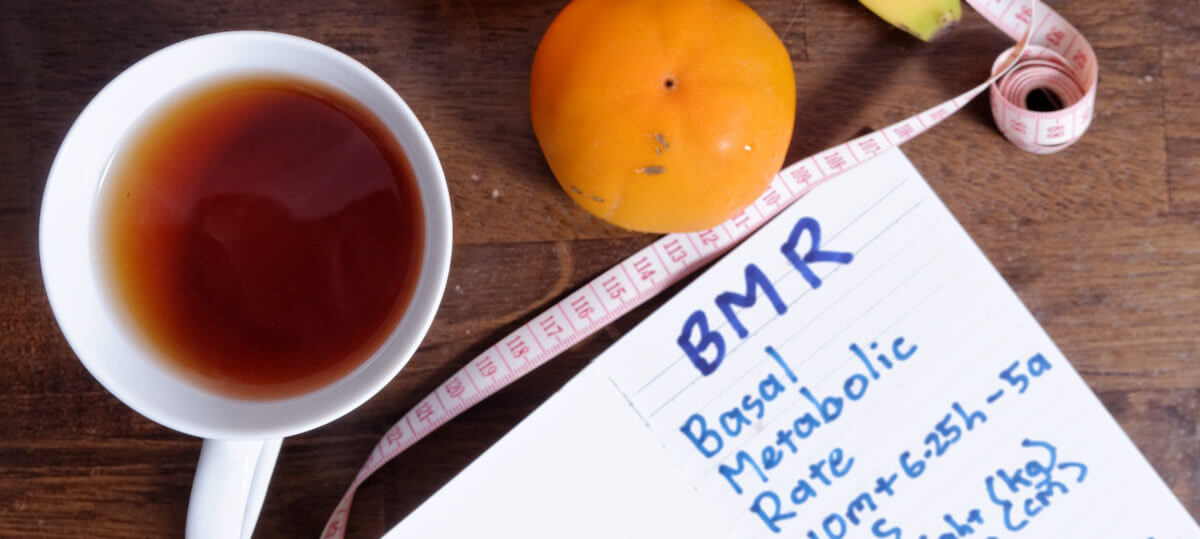
You probably don’t think about your body composition when you’re thinking about your metabolism. But you should.
You probably think about it in terms of speed: “My metabolism is fast” or “my metabolism is slowing down.” If that sounds like you, you’re not alone: simply googling the word “metabolism” yields 4 articles in the top 10 all based around boosting/increasing your metabolism for weight loss.
People are naturally afraid of their metabolism slowing and the weight gain they know comes with it. To some extent, those worries are well-founded.
Metabolism is linked with weight gain and loss because of its a biological process involved with energy and calories.
The Mayo Clinic defines metabolism as:
…the process by which your body converts what you eat and drink into energy. During this complex biochemical process, calories in food and beverages are combined with oxygen to release the energy your body needs to function.
Notice how it doesn’t mention anything about the speed you process your food. That would be digestion.
In medical terminology, metabolism is known as your Basal Metabolic Rate (BMR), which is the minimum number of calories your body needs to perform basic bodily functions. BMR is usually expressed in terms of calories. Your Basal Metabolic Rate also has another interesting quality: the more Lean Body Mass (which includes muscle, water, and minerals) you have, the greater your BMR will be.
When we talk about metabolism, we should always start the conversation with how many calories your body needs. But because your BMR and Lean Body Mass are linked, that means any conversation about metabolism becomes a conversation about your body composition.
Why is it that some people seem to be able to eat whatever they want and never experience any weight gain, while other people – even skinny people – feel like whenever they have one bite of dessert it instantly goes to their waistline?
The reason is that metabolism can vary in size.
Take a look at these two body composition profiles, and see if you can spot the difference.
Beyond the obvious differences in weight, the Person A has a much smaller Basal Metabolic Rate than the second. This means Person B needs more calories than Person A in order to provide their body with the necessary energy to function without losing weight. Because the BMR is bigger, the metabolism is “bigger.”
Greater than height and gender, the most important factor playing into BMR is the amount Lean Body Mass each person has. That’s because, as research in the American Journal of Clinical Nutrition states, the more Lean Body Mass you have, the greater your Basal Metabolic Rate will be. That is why strength training for muscle gain, which in turn will increase your lean body mass, is recommended as a way to increase your metabolism.
This is why people who are big or above average in weight can eat more than people who are smaller. Their body literally requires them to eat more to maintain their weight, and specifically – their Lean Body Mass.
OK, you say, but these two people are very different in body weight – of course, the second person will have a bigger metabolism. Take a look at the two people below, who we’ll call “Jane” and “Sarah”, two individuals who are similar body in age, height, weight, and gender.
Despite being similar in age, height, weight, and gender, these two people have very different body composition profiles. As a result, they have different Basal Metabolic Rates. Although Jane has a body weight within the normal range (identified by being near the 100% mark), her body composition is defined by having more fat mass and less lean body mass and skeletal muscle than Sarah.
The person below has a lower body fat percentage and more Lean Body Mass – which is why when looking at this person, you’d describe them as “lean.” Again, because this person has more than 10 pounds more Lean Body Mass, her Basal Metabolic Rate comes out over a hundred calories greater than the person above.




Let’s take a deeper look at what you might call a “slow” metabolism. Far from being an issue of fastness or slowness, weight gain is almost always the result of a caloric imbalance that goes unchecked over a long period of time.
But first, something needs to be clarified – your Basal Metabolic Rate is not the only factor that plays into your overall caloric needs, and it’s not the total amount of calories you need in a day. There are two other major influencers, which are:
These taken together with your Basal Metabolic Rate provide your Total Daily Energy Expenditure (TDEE). This is the number of calories your body burns in a day.
BMR is a necessary piece of information to estimate TDEE. Although they’re not exact, equations exist for estimating your TDEE based on your activity level and BMR. These are based on multiplying your BMR with an “activity factor” – a number between 1 and 2 – that increases the more active you are (and decreases when you are less active, regardless of your appetite).
To take a closer look into metabolism and weight gain, let’s take the two people whose body compositions we’ve looked at above, Jane and Sarah, and see what could happen in a real world example and accounting for diet and exercise.
For this exercise, we first need to estimate TDEE for Jane and Sarah, using their BMRs as a guide. Based on Jane and Sarah’s compositions, it would be fair to assume that Jane does less exercise/is less active than Sarah, so we’ll assign an activity level of “Sedentary” for Jane and assign “Lightly Active” for Sarah.




Using these numbers and multiplying it by the appropriate activity factor, we can estimate Jane’s TDEE to be 1573 calories and Sarah’s to be 1953 calories, a difference of 380 calories.
Notice how although the difference in BMR was a little over 100 calories when activity levels are factored in, the difference in actual caloric needs becomes magnified.
Now that we have an estimate of the calories Jane and Sarah will need/burn in a day, let’s give them calories to take in. Let’s put them both on a diet of 1,800 calories a day – the estimated caloric intake suggested by the USDA for sedentary women between the ages of 26-30.
Assuming that Jane and Sarah both follow the 1,800 calorie diet perfectly without any extra, high caloric snacks or treats, Jane would end each day with a calorie surplus of 227 calories/day. Sarah would end each day in a slight calorie deficit of 153 calories a day.
When you are in a caloric surplus – taking in more calories than you use – and live a mostly sedentary lifestyle, you will experience weight gain, specifically, fat. An extra 227 calories a day might not seem like a lot at first – that’s about a single soda -, but over time, a surplus of 227 calories a day becomes 1589 extra calories a week and a surplus of 7037 extra calorie a month: roughly 2 pounds of fat gain per month.




Bottom line: despite being the same height, same gender, similar weight, and similar ages, because of the difference between Jane and Sarah’s body compositions, Jane will experience weight gain over time while Sarah might experience some weight loss (because of her calorie deficit), even though their diets are the same. That’s because the differences in their caloric needs, although seemingly small at first, increase to significant differences when allowed to persist over time.
It’s not about their age or anything else; it’s about their body compositions determining their metabolism/caloric needs.




Because your metabolism isn’t something that slows down or speeds up depending on things like age, this actually gives you some control over it. With the correct exercise and dietary plan, you can make your metabolism work for you
It all goes back to improving and maintaining a healthy body composition.
Because your body needs more energy to support itself when it has more Lean Body Mass, working to increase your Lean Body Mass can actually increase your Basal Metabolic Rate, which can have a huge impact on your TDEE once you factor in your activity level.
For many people, simply maintaining their metabolism or avoiding a “slowdown” (which as we’ve seen, is a myth right up there with muscle turning into fat) is an important goal.
How can you avoid a decrease of your metabolism?
In short: by maintaining the Lean Body Mass that you already have. That means maintaining your Skeletal Muscle Mass.
Your Skeletal Muscle Mass isn’t the same as your Lean Body Mass, but it is the overall biggest contributor to it. It’s the muscle that you can actually grow and develop through exercise, and increases/decreases in SMM have a strong influence on increases/decreases in Lean Body Mass.
Skeletal Muscle Mass is best developed through strength training and resistance exercise along with a proper diet. A regular exercise plan that includes strength training and resistance exercise will help you maintain your Skeletal Muscle Mass.
This can be especially important as you age. As people become older and busier, activity levels tend to drop and a proper diet can become harder to maintain as responsibilities increase. Poor diet and nutrition can lead to loss of Lean Body Mass over time, which leads to a decrease in overall metabolism – not a slowdown.
The example of Jane is a good example of a well-intentioned dietary plan that doesn’t match the metabolism of the person practicing it.
Even though Jane has been led to believe that 1,800 calories is right for her based on age and gender, her metabolism doesn’t require that caloric intake, and she will end up gaining weight despite her efforts to eat a healthy diet. In the end, she will probably end up blaming her “slowing metabolism.”
It’s examples like Jane’s that show how important understanding the link between metabolism and body composition is.
How much Lean Body Mass do you have? What might your Basal Metabolic Rate be? These questions should be answered first before starting any weight loss or diet program, as well as conversations about metabolism.
The first step is always to get the information you need to get the answers to these questions by getting your body composition accurately tested. Your metabolism and your body composition are strongly linked, so in order to truly understand your metabolism and weight, you must get your body composition tested.

When people decide they want to get into shape, the first thing they typically do is sign up for a gym. They start off with great excitement, vowing to hit the treadmill or weight room every day. They keep this up for a couple of weeks, but when the changes don’t come, the enthusiasm wanes. Every day becomes three times a week. Three times a week becomes “I’ll go when I have time.” Before they know it, they’ve given up.
Sound familiar?
The reasons for giving up a fitness program are many, and not seeing results fast enough is one of the most common reasons to quit. However, many people forget one extremely important foundation for their weight loss program: their diet.
Perhaps you’ve heard the expression “six-pack abs are made in the kitchen.” It’s true. You can train as hard as you want in the gym, but you can’t out train a bad diet. Regardless if your goal is to gain muscle or lose fat, if you’re not optimizing your meals to reach those goals, you’re setting yourself up for failure.
So how do you optimize a meal plan? There are many factors that go into meal planning, such as the type of nutrients consumed, the frequency of meals, and the selective use of fasting to name a few. But a great place to start is to determine how many calories you burn a day. And it all starts with your Basal Metabolic Rate or BMR.
You’re probably familiar with the 2000-calorie diet. This is a range set by the U.S. Food and Drug Administration (FDA) in 1993 for use on nutrition labels for packaged food.




So what are your actual caloric needs? A good way to start is by using a BMR calculator, which will determine the number of calories your body burns each day to perform its basic, life-sustaining functions. This includes all the involuntary processes in your body such as breathing, digesting food, pumping blood, brain activity, and much more. There is no shortage of online resources and apps that will provide you with a BMR calculator. Certain medical/fitness devices also feature BMR as an output during body composition analysis. However, there are a few things you should know about metabolism calculations before diving into the first option you find. Your caloric needs can be calculated in a couple different ways and with a few different equations, including the revised Harris-Benedict equation and the Mifflin-St. Jeor equation. These equations calculate BMR using your weight, with some adjustments for height, age, and gender. However, if you fall outside average assumptions for height, age, and gender (if you’re an athlete, for example), these formulas may not accurately produce your metabolic rate.
For people who do fall outside the assumed ranges for height, age and gender, there is a third option: use the amount of lean body mass you have to determine your metabolic rate. This is what the J.J. Cunningham equation will do. Using this method as a BMR calculator has a couple of benefits:
Once you have your BMR in hand, you’re ready for the next step.
Remember, your BMR is just the number of calories your body burns at rest and does not account for the calories you need to walk, talk, exercise, etc. When thinking about your caloric needs for a meal plan, you’ll need to convert your BMR to your Total Daily Energy Expenditure (TDEE). You can do this by multiplying your BMR by a factor that represents your estimated energy level. Those conversions are:




So, let’s take the example of a 171.1-pound male with 133.6 pounds of lean body mass and assume he is moderately active. Using the Cunningham equation, this person would have a BMR of around 1,679 Cal/day. Multiply that by the appropriate conversion, and you get 2,602.45. This is how many calories this person needs to maintain his weight.
When trying to improve your body composition and body fat percentage, you must reduce fat mass and gain lean body mass. That’s why it’s very hard to change your body composition.
This also means that your diet must also match what your current goal is – losing fat mass and/or gaining lean body mass. This is incredibly important. People who don’t do this often end up sabotaging their goals by setting fitness and meal plans that are at odds with each other.
The most classic example is this: “I want to get in shape, so I am going to diet (eat less) and work out more (increase energy use).”
This isn’t a bad plan – if you’re looking to lose fat. If you’re looking to build muscle and get stronger, it’s very unlikely that you will achieve this by eating less than your TDEE while increasing your activity level beyond what you’re is accustomed to.
How many calories do you need to take out of your diet in order to lose weight? Theoretically, any amount that is less than your normal TDEE can cause you to lose weight; it just depends on how quickly you want to see results.
A lot of resources will tell you that you need to subtract 500 calories from your diet each day to lose one pound of fat per week. This is based on the premise that one pound of fat represents 3,500 calories, and that by reducing your caloric intake by 500 over 7 days, you’ll reach a weekly loss of 3,500 calories or a pound of fat. You may have heard this rule before.
However, hard-and-fast “rules” like these are tricky because although they’re usually based on facts (caloric reduction does lead to fat loss), they may not be advisable, recommended, or safe for everyone. Someone with a TDEE of around 2,600 calories might not have many problems dropping to 2,100, but someone whose TDEE is 1,400 will probably have significant difficulties living a normal life and exercising while consuming 900 calories a day for any length of time.
The safest way to handle a caloric reduction is to reduce your intake by something marginal – 200 or 300 calories a day, for example – and be consistent with this for a week or two. After a week, have your body composition analyzed to ensure you aren’t losing lean body mass. If you see your fat mass begin to drop, you can see by how much and adjust your caloric needs accordingly.
How can you cut calories safely? The first thing to do would be to cut any unnecessary snacks and treats in your diet – soda, chips, chocolate, alcohol, etc. Depending on how much of these existed in your diet before, this simple step might be enough to cause you to lose weight without making any other changes!
But what if you were already eating clean? Where do you cut calories on a clean diet? If you’re in this situation, you need to make sure that you are cutting calories from nutrient sources that you can afford to cut from. One nutrient group you should be careful to not cut too much from (if at all) is protein.
Protein helps ensure your weight loss is fat mass and not fat free mass or lean body mass. Find out how much protein should you eat for your body here.
One way to do this from a dietary standpoint is to consume foods that are low in calories but high in protein. Here are a couple of foods to consider:
With proper caloric restriction, nutrition, and exercise, you’ll start to shed off the fat while retaining as much muscle as possible.
Start with your BMR and convert it to TDEE by multiplying it by the factor that best reflects the amount of physical activity you have in a week. For the sake of consistency, we will use the previous example (1679 Cal/day) and exercise factor (x1.55) to produce a TDEE of 2,602.45. This is the amount of calories that must be exceeded in order to have enough energy to produce the desired results.
How much should you increase your energy intake by in order to gain lean mass? According to research, you need to consume approximately 15% more calories per day than what is required to maintain your body weight (that’s the TDEE). So in this example, this individual should look to increase their caloric intake to about 2992.3 calories which, for convenience’s sake, could be safely rounded off to an even 3,000 calories/day.
How should you be adding these extra calories in your diet? The study cited above suggests that to maximize lean mass gain while minimizing fat mass gain, the increase in calories should be made up of both protein-rich foods and carbohydrates.
However, a word of caution about protein. Before you conclude that you’ll just increase your diet with nothing but protein, consider this: there is a point where eating more protein won’t lead to a measurable increase in lean mass. In a 2006 study of collegiate level athletes, no benefit in muscle or strength gain came from protein consumption that exceeded .9 g of protein per pound of body weight.
While protein is important, caloric intake is arguably more necessary. In the article cited above, the athletes consumed their required protein amount but failed to consume the total amount of calories appropriate for their fitness level, which led the authors to comment:
The low energy intakes observed in this study confirm previous reports that have shown that collegiate athletes generally do not meet their nutritional needs, specifically as it relates to energy intake. Caloric intakes of strength/power athletes should exceed 44 – 50 kcal·kgBM·day-1, however, the caloric intakes reported in this study (33.0 ± 5.5 kcal·kgBM·day-1) were below these recommended levels and likely impacted the ability of these subjects to make significant gains in lean tissue accruement.
Bottom line: you need to exceed the number of calories you require each day if you are trying to gain lean mass.




As with any dietary plan, you will expect to see changes over time. All this hard work has to produce results, right? So, how long will it take to see results? Unfortunately, that is going to vary for each individual. A good rule of thumb is to weigh yourself every 1 – 2 weeks. If you are looking for a more precise analysis, you should get your body composition measured as well. Another important factor to consider: your BMR. Since your BMR is closely linked to your lean body mass, any changes will affect the number of calories you burn.
For example, if your plan is to gain lean body mass, and over a period of time you are successful in doing so, your energy needs are going to increase. This is why it is so important to be measuring body composition.
Conversely, if you lose some lean body mass as a result of going on a strict caloric deficit diet, your BMR will decrease. If you lose too much lean mass, but don’t take that change into account, you might take in more calories than you need, which could sabotage your goals.
Finally, a diet is much more than creating a calorie deficit. It’s important to use a BMR calculator or body composition analyzer to understand how much energy your body needs. Without this information, you won’t know how much food you need to add or remove to your diet in order to achieve your goals. With this information, you’ll see quicker results and reach your goals faster.

“I used to be fit, but then I stopped exercising and it all turned to fat.”
Sound familiar?
It doesn’t seem like it should make sense – that muscle can turn into fat – but everyone’s seen the retired professional athlete who got really fat.
Well, here it is in black and white (and in bold): No. Muscle does not “turn into fat.” Period.
There is no process in the human body by which muscle – which is made up of mainly protein, amino acids, and water – transforms itself into adipose (fat). The human body, no matter how amazing it can be at times, cannot magically turn one tissue into another.
So then, what’s going on?
The illusion of “muscle turning into fat” becomes believable for many people when they don’t see their weight change over time, yet see themselves get fatter. While muscle turning into fat is a myth, the possibility of your body fat percentage rising over time definitely isn’t, and that’s what’s actually happening.
So what’s actually happening? It is simply a negative change in body composition.
Specifically, it’s a loss of Skeletal Muscle Mass combined with a gain of Fat Mass occurring at about the same rate, at about the same time. How does this happen, and how can you avoid this? Let’s take a closer look.
Here’s what a 7-pound decrease in muscle and a 7-pound increase in fat would look like in someone who weighed 261.9 pounds with a body fat percentage of 13.0%:




Results completed on the InBody 570.
Notice how as Lean Body Mass drops, Skeletal Muscle Mass drops with it. Because the Lean Body Mass decrease matches the Fat Mass increase, this person’s weight doesn’t change.
However, this person’s body fat percentage increased from 13.0 to 15.7. The increased body fat percentage combined with the lack of body weight change creates the illusion that muscle is transforming into fat, when in reality it’s just an increase in body fat disguised by no change in scale weight due to muscle loss.
How do things like this happen, and why does it seem to happen to people who are or used to be very fit? It starts with muscle loss.
Although you may not realize it, you “lose muscle” every minute you are alive. That’s because your muscles, like any other tissue in your body, depends on cell turnover and protein synthesis. This means that your body is continually breaking down the protein in your muscles and rebuilding them. You want your body to do this – it’s part of what’s keeping you alive!
Skeletal muscle can be grown and developed through proper nutrition – which includes consuming sufficient protein to provide the necessary amino acids – and through physical activity. The converse is also true: if you become less physically active and/or your diet can no longer support the development of increased muscle tissue, you will enter a catabolic (tissue-reducing) state known as muscle atrophy.
Muscles that are partially used – using less than 20% of their maximum force – will start to atrophy over the long term. Complete disuse is even worse: muscles that are completely unused, such as when someone is bedridden and performs very little movement, can degrade by about 1/8 of their strength per week.
Of course, if you don’t have any major health complications, your muscles are not going to degrade at such a significant rate as someone who is bedridden. However, if your body was used to operating at a high, athletic level and you suddenly stop exercising, your body won’t see any reason to maintain your muscles at that level and will begin to atrophy.
And what takes its place instead? Fat!
But where does the fat come from?
The same place it always comes from: an energy surplus – caused by eating more than you’re burning. Although for many people this isn’t exactly news, it can catch people by surprise, especially people who are used to being athletic and fit.
Athletes require massive amounts of energy in order to perform at a high level. And this energy demand requires large amounts of all major macronutrients. In order to get that energy, they need to eat – and eat a lot. According to an interview given by Susan M. Kliner, a nutritional consultant for the Seattle Seahawks, NFL quarterbacks required somewhere between 4,000 to 6000 calories, spread out over about 6 meals per day in order to be in ideal playing shape.
A major reason why high-performance athletes like NFL quarterbacks require so many calories is that they typically have higher-than-average amounts of Lean Body Mass as compared to average people at the same height. That’s significant because as Lean Body Mass increases, Basal Metabolic Rate (BMR) increases. BMR is the number of calories a body needs at rest, not including what is needed for movement and digesting food.
Here’s an example of someone whose body composition falls into the athletic profile:
The Lean Body Mass, SMM, and Basal Metabolic Rate was measured using the InBody 570.
Notice the high values for Lean Body Mass and Skeletal Muscle Mass. This contributes towards the BMR value of 2,602.
However, BMR is not the total calories you need a day. A more appropriate number is the Total Daily Energy Expenditure (TDEE), of which BMR is one part. In order to calculate TDEE, you’ll first need to determine BMR and then multiply it by a factor determined by how active you are.
Professional football players would fall under “extremely active” as their full-time job involves very high amounts of physical activity. Taking the BMR in our example and multiplying it by 1.9 would result in a TDEE of 4,943.8, consistent with the statements made by Dr. Kliner.
Extremely Active: 2602 (BMR) x 1.9 (Activity level) = 4,943.8 (TDEE)
What’s important to remember is that this number is the amount of calories that this individual needs to consume maintain his weight due to his Lean Body Mass, and critically, at his current activity level.
What would happen if this person stopped being so active and took an office job – jobs that are typically sedentary? TDEE would plummet quickly because the activity level would drop significantly.
Let’s say that this individual decided to continue being active while working at this office job and worked out enough to be classified as “moderately active.” Assuming that BMR remains consistent, this person’s TDEE would be 4,033.1. That’s a difference of 910.7 calories, or eating approximately 22 strips of pan-fried thick cut bacon on top of what you usually eat.
Extremely Active: 2,602 (BMR) x 1.9 = 4,943.8 (TDEE)
Moderately Active: 2,602 (BMR) x 1.55 (Activity level) = 4,033.1 (TDEE)
Caloric Surplus: 4,943.8 (Old TDEE) – 4,033.1 (New TDEE) = 910.7 calories
In the example above, if this person continued to eat at the same level they did when they were extremely active, they would be in a caloric surplus of 910.7 a day, or an extra 6,374.9 calories a week.
What happens when the body remains in a caloric surplus for an extended period of time? Fat gain!
So tying it all together, it isn’t that your “muscle turns into fat.” From a body composition standpoint, here is what is happening:
Now that we know what is happening, how do we make sure it doesn’t happen to us?
People who are at risk for gaining large amounts of fat are, somewhat ironically, people who are at their fittest right now. That’s because when you’re at your fittest, the amount of nutrients you are consuming is necessary fuel to help the body recover after a tough workout. You’re in balance.
The problem is, people become accustomed to eating a certain amount of food, especially when they have lived a certain way for many years. They develop a mental understanding of how much they can eat, and they often order and/or cook portion sizes that match this mental understanding of how much food they need.
Although it is a challenge, here are three steps you can get back on track.
Testing your body composition regularly is the best way to ensure that you’re staying at the level you want to be.
By tracking your body composition, you will be able to track Lean Mass and Fat Mass gain or loss. With that kind of information, you’ll be able to make the changes you need to ensure that you stay as fit and healthy.
You must adjust your diet to match your current activity level, or you will risk running a caloric surplus. That change might be more than you’d expect, too.
A great way to optimize your diet is to use BMR which will make sure you are getting enough nutrients to fuel muscle growth, but also lose that stubborn belly fat.
Find new ways to increase your activity level that works with your current lifestyle. Although you may no longer be performing at high levels every day, you can find new ways to be active on a schedule that works for you.
Two days of strength training a week has both great physical and mental benefits.
Remember the key is to maintain the balance between food consumption and exercise intensity that fits your current lifestyle. Once you achieve that balance, you lose the extra fat start getting your old athletic body back.